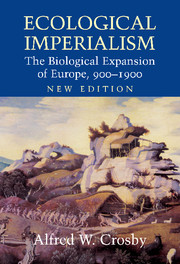Book contents
- Frontmatter
- Dedication
- Introduction
- Contents
- List of illustrations
- Preface to the new edition
- Acknowledgements
- 1 Prologue
- 2 Pangaea revisited, the Neolithic reconsidered
- 3 The Norse and the Crusaders
- 4 The Fortunate Isles
- 5 Winds
- 6 Within reach, beyond grasp
- 7 Weeds
- 8 Animals
- 9 Ills
- 10 New Zealand
- 11 Explanations
- 12 Conclusion
- Appendix: What was the “smallpox” in New South Wales in 1789?
- Notes
- Index
10 - New Zealand
Published online by Cambridge University Press: 05 August 2013
- Frontmatter
- Dedication
- Introduction
- Contents
- List of illustrations
- Preface to the new edition
- Acknowledgements
- 1 Prologue
- 2 Pangaea revisited, the Neolithic reconsidered
- 3 The Norse and the Crusaders
- 4 The Fortunate Isles
- 5 Winds
- 6 Within reach, beyond grasp
- 7 Weeds
- 8 Animals
- 9 Ills
- 10 New Zealand
- 11 Explanations
- 12 Conclusion
- Appendix: What was the “smallpox” in New South Wales in 1789?
- Notes
- Index
Summary
The varieties of man seem to act on each other in the same way as different species of animals – the stronger always extirpating the weaker. It was melancholy in New Zealand to hear the fine energetic natives saying, that they knew the land was doomed to pass from their children.
—Charles Darwin, The Voyage of the Beagle (1839)A virgin countryside cannot be restocked; the vicissitudes of its pioneers cannot be re-enacted; its invasion by alien plants, animals and birds cannot be repeated; its ancient vegetation cannot be resuscitated – the words terra incognita have been expunged from the map of little New Zealand.
—H. Guthrie-Smith, Tutira, the Story of a New Zealand Sheep Station (1921)We have discussed the American and Australian Neo-Europes topically – weeds, then animals and germs – in order to tease out evidence of the ecological factors underlying the success of European colonies there, but we have not tried to r e weave the history of, say, the pampa into a narrative. The stories of all the continental Neo-Europes are too long and complicated to tell within the limitations of this book. Therefore, we turn to New Zealand, insular and comparatively small, whose history is the briefest and most fully documented among all the Neo-Europes. New Zealand is a palimpsest written on by only a few people, and only recently. It would be better for our purposes if New Zealand's indigenes had been Paleolithic or New World Neolithic when the marinheiros first came – purely non–Old World Neolithic, to be clear about it, like those of all the other Neo-Europes.
- Type
- Chapter
- Information
- Ecological ImperialismThe Biological Expansion of Europe, 900–1900, pp. 217 - 268Publisher: Cambridge University PressPrint publication year: 2004

